I Think I’ve Found My Dream STEM School
A MiddleWeb Blog
 I’m ready to toss aside my twice-flunked retirement and rush back to the classroom. Not just any classroom, mind you, but a classroom in a specific middle school – Phinnize J. Fisher in Greenville, S.C. If I’ve ever seen a school designed to facilitate real learning, it’s this one.
I’m ready to toss aside my twice-flunked retirement and rush back to the classroom. Not just any classroom, mind you, but a classroom in a specific middle school – Phinnize J. Fisher in Greenville, S.C. If I’ve ever seen a school designed to facilitate real learning, it’s this one.
I first read about Fisher Middle School when John Norton, one of my wise and wonderful MiddleWeb editors, sent me a link to this article in The Atlantic. I clicked on the link and what popped up was truly the “dream STEM school” from my perspective. (Fisher actually bills itself as a STEAM school.)
In my area, most middle schools are struggling to fit an action-packed, inquiry-based STEM curriculum into a traditional school facility following a traditional school schedule. That’s obviously not what’s going on at Fisher Middle School.
Imagine large open spaces, learning studios, commons areas, bright seminar rooms, glass wall dividers – you name it. In fact, why don’t you look at it.
I located this short video about the school (check it out) and was soon so intrigued that I decided to give the school’s principal, Jane Garraux, a call. She returned my call quickly, and I began probing for more information about the school and its programs.
The school facility
How did this school come about? I asked Ms. Garraux, and she explained. The Greenville County School District needed a new middle school. Before building this school, they did plenty of homework, researching methods by which students best learn, and discovered a clear winner. Deeper, lasting learning results when kids work for an extended period to investigate and solve real-world, open-ended problems and create solutions – a teaching approach known as project-based learning (PBL) and used, along with an inquiry approach, in teaching STEM.
The district then met and collaborated with area business leaders who urged them to focus on engineering and the STEM subjects, along with a healthy dose of arts. The district agreed and set its sights on a schoolwide STEAM curriculum, teaming with education and STEM-related faculty at nearby Clemson University to think through the teaching and learning process.
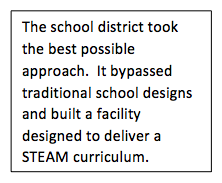
I really like the district’s solution for that challenge!
A closer look inside the school
The classrooms at Fisher are not your traditional classrooms. These flexible learning spaces can easily shift shape and size, depending on the nature of the day’s activities. Natural light pours in through large, plentiful windows and movable glass walls. Kids move smoothly between learning studios, collaborative workspaces, innovation labs, a large outdoor courtyard, and an amphitheater.
According to Principal Garraux, the students love having spaces to spread out, study together, and discuss their work. I can believe it. I wish my students had such a learning space constructed for them.Take a look at these learning spaces in action; this is a must-see video.
Obviously, the school design and resulting school climate allow for more effective STEAM teaching and learning. Fisher has built-in, daily opportunities for students to practice those all-important interpersonal skills that make them successful adapters, communicators, problem-solvers, and collaborators.
Whether it’s acquiring knowledge, questioning, thinking critically, connecting, or designing products and creations – the process is easier when the environment is right.
Fisher Middle School is the prototype for a 21st Century school designed to look like the 21st Century workplace. One of my sons works at the NOAA National Water Center – a contemporary facility that uses the same style of design as this middle school: large open areas, lots of natural lighting, collaboration areas, studios, hangout rooms, and so on. If you’ve read about the Google campus, you know it has similar designs. Students from Fisher Middle School will feel right at home in modern-day workplaces.
Technology
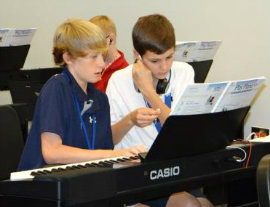
Fisher is a personalized learning school. All kids have laptops that hold all of their textbooks. They do their classwork on their laptops using Google Classroom. They study video game design, coding, and even have a Digital Piano Lab. And their music is located . . . yep, you guessed it . . . on their laptop screens. Not surprisingly, their school Media Center is mostly digital. Does a student need a particular book? No need to wait until someone returns a hard copy. This Media Center provides eBooks. Check ‘em out without a wait.
The STEAM curriculum
I asked Garraux to talk a bit about the STEAM curriculum itself. She confirmed that all STEM components are in place: math and science are integrated and kids use an engineering design process to work on solutions for real-world problems. But the curriculum goes beyond math and science. At Fisher, Arts are meaningfully combined with the STEM subjects.
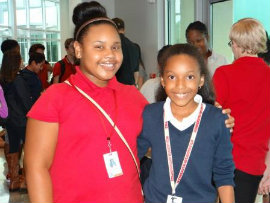
Garraux noted that, at Fisher, art includes more than the traditional music and visual arts. “Arts” is defined broadly to include public speaking, drama, debates, journalism, creative writing, and aspects of the language arts. Using that understanding of the arts, the fit with STEM subjects becomes much more natural.
In talking with Garraux about the curriculum, I found my biggest takeaway was this: at Fisher Middle School, project-based STEAM learning goes on every day in every subject.
Teacher collaboration
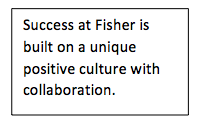
Fortunately, Fisher is designed for teacher learning and planning as well as student learning. In fact, the only permanent structures in the Fisher facility are the teacher collaboration rooms. These serve as a favorite spot for teachers from the different subject areas to meet, plan, and integrate their curriculum.
Teachers have time during the school day scheduled for this – 90 minutes every other day. (The school is on a block schedule so that each block of learning time is 90 minutes long – for kids as well as teachers – and classes meet every other day.) Garraux attributes the positive professional culture in the school to this regular, in-depth collaboration.
 A school-to-watch for all STEM advocates
A school-to-watch for all STEM advocates
So let’s add it up: A bright, spacious facility that accommodates movement and activity; technology as an integral part of student learning; a project-based, integrated STEAM curriculum; built-in teacher collaboration and learning – what a recipe for STEM and STEAM success! And what a recipe for students who will be well prepared to enter a contemporary workforce.

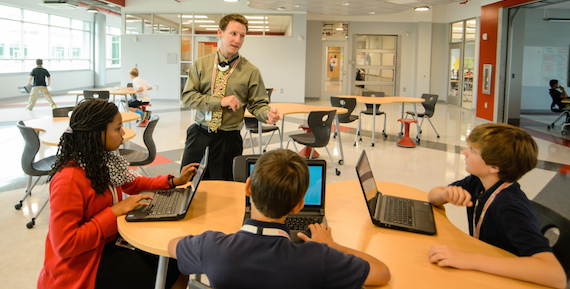





























My daughter attends this school. My greatest joy is that everyday she comes home excited about her day!! I love this school, it is truly a STEAM school with heart!
I can imagine that your daughter is loving her new school program! Your message reminds me of how important it is to make our girls aware that they, too, can be engineers, scientists, and mathematicians! We need them in these fields.
One school gets all the money and tech in the district. Other schools and students suffer due to it.
M, I understand your feelings. In the district where I taught (Mobile, AL) a new middle school was needed. The system designed and built a new state-of-the-art middle school that was a “jaw-dropper.” It did seem that kids still going to the traditional schools were at a disadvantage. But some school had to be the “trend-setter” as there was never enough money to upgrade all schools at once. (The system where I worked has 15 middle schools.)
Over time, many features in the new school were incorporated in other schools as they were upgraded and renovated. Now everyone is waiting for the next, best new school to be built – one that will launch kids into the 21st century for real and set the vision. I think I may have seen that in Fisher MS. It’s a wonderful model, and I hope that the lessons learned there will now be passed along to children in other middle schools.
Thank you Anne for discovering our ‘dream” school. It is great to have this as a model as I work with other schools and teachers hoping to engage students and implement STEM into STEAM. I am impressed with the risk taken by the principal, Jane Garraux, who believes this is truly the best way to learn and now there are results.
In our long quest for defining what makes a good STEAM curriculum or program, I have always understood the benefits and use for the arts in STEM. After all, STEM was never devoid of the arts! It takes some risk and trust to do it, and PBL is the way to go. I love the open classrooms with so much room to explore. Thank you! Readers can follow our work at: Enhancing STEM: The Arts Effect
I knew you would love this school, Ruth! With your passion and knowledge about STEAM, this is right down your alley – and mine, too! Couldn’t wait for you to see what’s happening in schools right now. I’m looking for more STEM/STEAM schools!